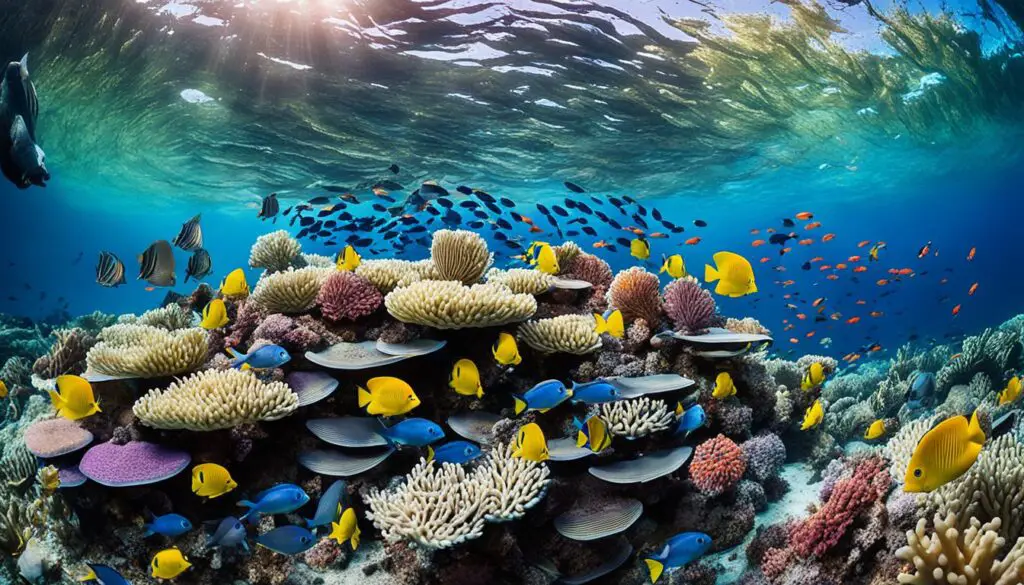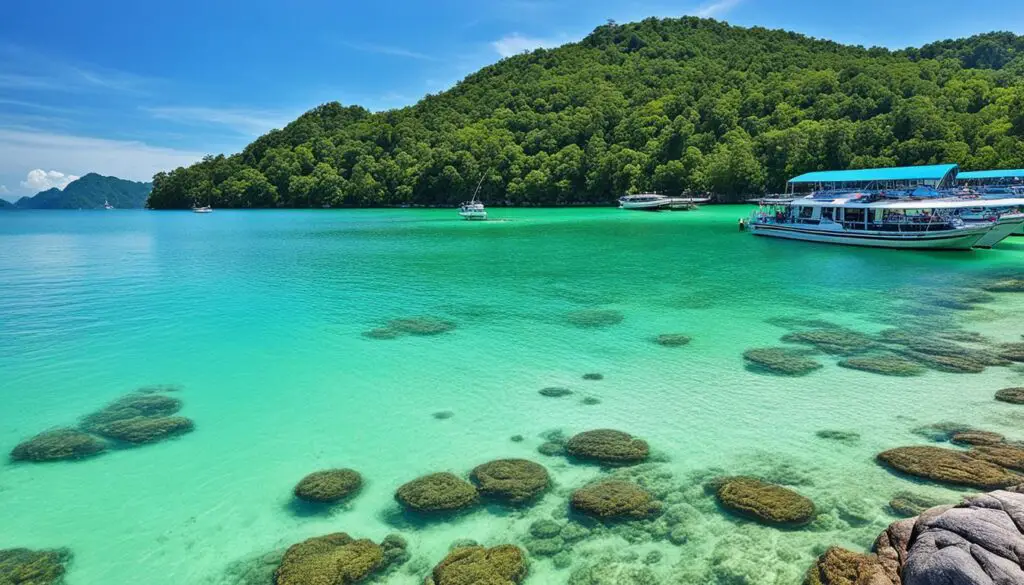The world’s coral reef ecosystems are under threat from various factors, including warming waters, pollution, and invasive species. One often overlooked danger is the inadvertent introduction of non-native coral species by well-meaning individuals. These foreign corals can outcompete native species and spread diseases, leading to detrimental consequences for the delicate balance of the reef.
In the picturesque island of Kaua’i, Hawaii, one nonprofit organization stands as a guardian of the reef. Reef Guardians, with their dedicated team of passionate individuals, work tirelessly to protect the local coral ecosystems from invasive species and other threats. Their efforts have been particularly focused on removing non-native corals commonly used in saltwater aquariums.
These vibrant and exotic corals, favored by aquarium enthusiasts, may seem harmless when placed in fish tanks. However, once introduced into the ocean, they can quickly outcompete native corals for space and resources, leading to a disruption in the delicate ecological balance. Moreover, they can also spread diseases, further aggravating the health of the reef.
Proper disposal of aquarium animals and plants is essential to prevent the accidental release of non-native species. By working together to promote responsible aquarium practices and educating the public about the importance of protecting coral reefs, we can ensure the long-term health and sustainability of these precious marine ecosystems.
Key Takeaways:
- Protecting coral reefs from invasive species is crucial for maintaining their delicate ecological balance.
- Non-native corals commonly used in aquariums can harm native species and spread diseases in the ocean.
- Reef Guardians in Kaua’i, Hawaii actively work to remove non-native corals and protect the coral reef ecosystems.
- Proper disposal of aquarium animals and plants is essential for preventing the accidental introduction of non-native species.
- Education and awareness about responsible aquarium practices are vital for the long-term preservation of coral reefs.
Climate Change and Invasive Species Threaten Adriatic Fish Stocks
In the pristine waters of the Adriatic Sea, Croatian fishermen like Marko Kristic once enjoyed plentiful fish stocks and thriving ecosystems. However, the Adriatic’s delicate balance has been disrupted by the combined forces of climate change and invasive species.
One of the main culprits is the parrotfish, originally from the Mediterranean, which has made its way into the Adriatic due to warmer waters and increased maritime traffic. This invasive species poses a significant threat to the native fish population, outcompeting them for resources and disrupting the food chain.
“The invasion of parrotfish has been devastating for us fishermen. They decimate our traditional fishing grounds and leave us with diminishing catches,” said Marko Kristic, a third-generation fisherman from Croatia.
But the parrotfish is not the only invader wreaking havoc in the Adriatic Sea. The region has also seen the arrival of other invasive species, such as the poisonous lionfish and stonefish. These dangerous predators not only endanger native fish species but also pose risks to human divers and swimmers.
Unfortunately, the decline in fish stocks cannot be solely attributed to invasive species. Overfishing and climate change have also contributed to the fragile state of the Adriatic ecosystem. The combination of excessive fishing pressure and rising sea temperatures has led to the depletion of key fish populations, disrupting the delicate balance of the underwater world.
It is imperative to take immediate action to protect the Adriatic’s fish stocks and restore balance to its ecosystems. Conservation efforts should focus on reducing the impact of invasive species, implementing sustainable fishing practices, and mitigating the effects of climate change.

Conservation Actions for the Adriatic Sea
The table below highlights key conservation actions that can help safeguard fish stocks in the Adriatic Sea:
| Conservation Actions | Benefits |
|---|---|
| Implement stricter regulations on fishing practices | Prevents overfishing and allows fish populations to recover |
| Monitor and control maritime traffic | Reduces the spread of invasive species and protects native marine life |
| Establish marine protected areas | Preserves and restores critical habitats for fish species |
| Invest in research and monitoring programs | Provides valuable data for informed decision-making and adaptive management |
| Raise awareness about the importance of sustainable fishing practices | Encourages consumer choices that support responsible fishing |
By implementing these conservation actions and promoting sustainable practices, we can work towards restoring the Adriatic Sea’s fish stocks and protecting its delicate marine ecosystems for future generations.
Malaysia’s Most Beautiful Places: Exploring Pristine Islands and Rainforests
When it comes to scenic places, Malaysia offers a diverse range of breathtaking destinations that are sure to captivate travelers. From pristine islands with azure beaches to ancient rainforests teeming with wildlife, this Southeast Asian country has it all.
Langkawi: Paradise Islands
One of Malaysia’s most popular tourist destinations, Langkawi is an archipelago of tropical islands located in the Andaman Sea. With its crystal-clear waters, powdery white beaches, and lush rainforests, Langkawi is a true paradise for nature lovers. Visitors can enjoy a variety of water sports such as snorkeling, scuba diving, and jet skiing, or simply relax on the idyllic beaches.

Taman Nagara National Park: Into the Wilderness
For those seeking a true adventure in the heart of nature, Taman Nagara National Park is a must-visit. This 130 million-year-old rainforest in Pahang is one of the oldest rainforests in the world. It is home to a diverse range of flora and fauna, including rare and endemic species. Visitors can embark on thrilling jungle night walks, explore the Canopy Walkway for a bird’s-eye view of the forest, or go on a river cruise to discover hidden waterfalls and breathtaking landscapes.
Melaka City and George Town: Cultural Heritage
Step back in time and explore the rich cultural heritage of Malaysia in Melaka City and George Town. Both cities are UNESCO World Heritage Sites and are known for their well-preserved historical buildings, multicultural influences, and vibrant street art. Wander through the narrow streets, visit iconic landmarks such as St. Paul’s Church and A Famosa Fort in Melaka City, or admire the colorful colonial architecture and bustling markets in George Town.
Danum Valley Conservation Area: Wildlife Encounters
If you’re a wildlife enthusiast, a visit to Danum Valley Conservation Area in Sabah is a must. This pristine rainforest is home to a remarkable array of wildlife, including orangutans, pygmy elephants, and rare bird species. Nature lovers can participate in guided hikes, wildlife safaris, or even spend the night in a jungle lodge to fully immerse themselves in the beauty of this untouched wilderness.
Whether you’re seeking relaxation, adventure, or cultural exploration, Malaysia’s scenic places have something for everyone. From the idyllic islands of Langkawi to the ancient rainforests of Taman Nagara National Park, the rich cultural heritage of Melaka City and George Town, to the wildlife encounters in Danum Valley, Malaysia truly offers a world of wonders.
Conclusion
Protecting coral reef ecosystems and addressing the threats they face is crucial for preserving biodiversity and ensuring the sustainability of marine environments. The delicate balance of these underwater habitats is under constant pressure from factors such as climate change, invasive species, and irresponsible aquarium practices. It is imperative that we take action to safeguard these invaluable ecosystems to protect the diverse marine life they support.
Efforts to combat invasive species play a vital role in coral reef conservation. The introduction of non-native coral species, as discovered by Reef Guardians in Kaua’i, Hawaii, can have devastating effects on native species and the overall health of the reef. Responsible disposal of aquarium animals is essential to prevent the inadvertent introduction of these harmful species into the wild, helping to maintain the delicate ecological balance of coral reefs.
The impacts of climate change pose another significant threat to coral reef ecosystems. Rising sea temperatures and ocean acidification have detrimental effects on coral health and growth. Mitigating climate change impacts through collective action and global initiatives is essential for the long-term preservation of coral reefs.
By working together with conservation organizations, research institutes, and passionate individuals, we can actively contribute to the protection of these fragile ecosystems. By raising awareness about the importance of coral reef conservation and supporting sustainable practices, we can ensure the survival of coral reefs and the biodiversity that depends on them. Let us unite our efforts to create a future where our coral reefs thrive and continue to support a vibrant and diverse marine ecosystem.
FAQ
What are the threats faced by coral reefs?
Coral reefs face numerous threats, including warming water, pollution, and invasive species.
How do non-native corals affect the local ecosystem?
Non-native corals can outcompete native species and spread disease, causing negative consequences for the local ecosystem.
What is the importance of disposing of aquarium animals properly?
Proper disposal of aquarium animals is crucial in preventing the introduction of non-native species to native ecosystems.
What challenges are Croatian fishermen facing in the Adriatic Sea?
Croatian fishermen in the Adriatic Sea are facing challenges from climate change and the invasion of new species.
How are invasive species threatening Adriatic fish stocks?
Invasive species like the parrotfish, lionfish, and stonefish threaten the native fish population and impact the livelihoods of fishermen.
What are some notable scenic places in Malaysia?
Malaysia offers a variety of scenic places, including Langkawi, Taman Nagara National Park, Melaka City, George Town, and the Danum Valley Conservation Area.
What can visitors experience in Taman Nagara National Park?
Visitors to Taman Nagara National Park can experience attractions like the Canopy Walkway and jungle night walks while admiring the endemic wildlife.
What do Melaka City and George Town showcase?
Melaka City and George Town showcase Malaysia’s rich cultural heritage with their architectural landmarks and historical sites.
Why is protecting coral reef ecosystems important?
Protecting coral reef ecosystems is crucial for preserving biodiversity and ensuring the sustainability of marine environments.
How can individuals contribute to the conservation of coral reefs?
Individuals can contribute to the conservation of coral reefs by promoting responsible aquarium practices and supporting conservation initiatives like Reef Guardians.
